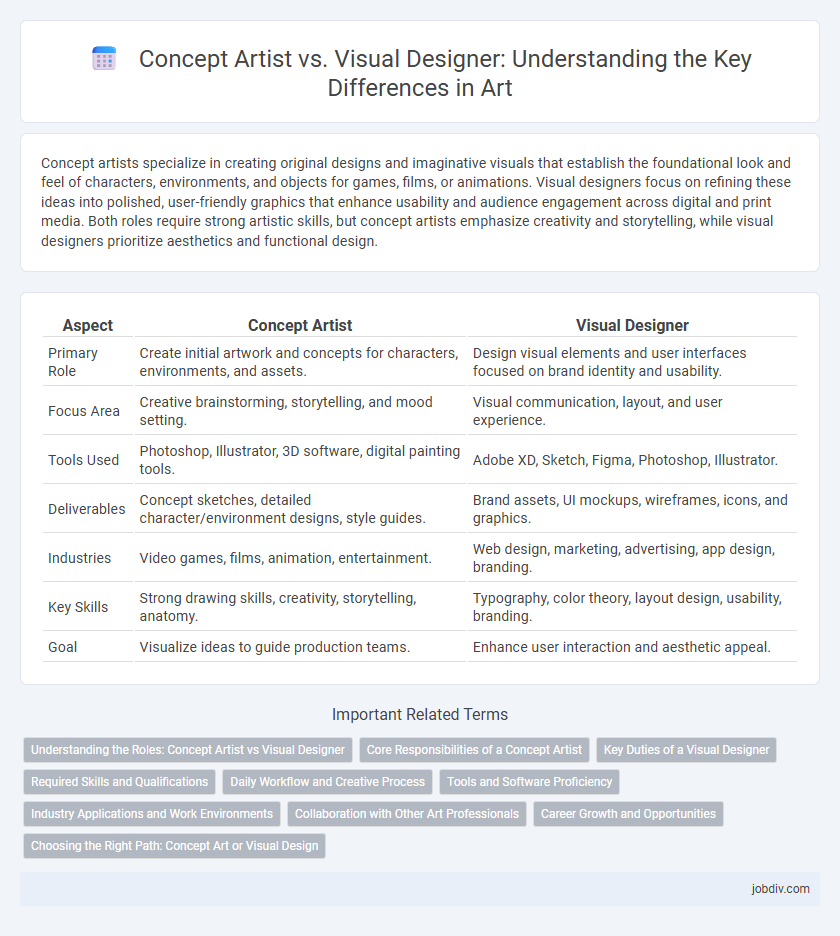Concept artists specialize in creating original designs and imaginative visuals that establish the foundational look and feel of characters, environments, and objects for games, films, or animations. Visual designers focus on refining these ideas into polished, user-friendly graphics that enhance usability and audience engagement across digital and print media. Both roles require strong artistic skills, but concept artists emphasize creativity and storytelling, while visual designers prioritize aesthetics and functional design.
Table of Comparison
| Aspect | Concept Artist | Visual Designer |
|---|---|---|
| Primary Role | Create initial artwork and concepts for characters, environments, and assets. | Design visual elements and user interfaces focused on brand identity and usability. |
| Focus Area | Creative brainstorming, storytelling, and mood setting. | Visual communication, layout, and user experience. |
| Tools Used | Photoshop, Illustrator, 3D software, digital painting tools. | Adobe XD, Sketch, Figma, Photoshop, Illustrator. |
| Deliverables | Concept sketches, detailed character/environment designs, style guides. | Brand assets, UI mockups, wireframes, icons, and graphics. |
| Industries | Video games, films, animation, entertainment. | Web design, marketing, advertising, app design, branding. |
| Key Skills | Strong drawing skills, creativity, storytelling, anatomy. | Typography, color theory, layout design, usability, branding. |
| Goal | Visualize ideas to guide production teams. | Enhance user interaction and aesthetic appeal. |
Understanding the Roles: Concept Artist vs Visual Designer
Concept artists focus on creating initial visual representations and ideas for characters, environments, and assets, often working in entertainment industries like gaming and film. Visual designers emphasize refining these concepts to develop cohesive, polished visuals that communicate brand identity and user experience across digital and print media. Both roles require strong artistic skills, but concept artists prioritize imaginative creation while visual designers focus on aesthetics and functionality in final designs.
Core Responsibilities of a Concept Artist
Concept Artists specialize in creating original visuals that define the mood, style, and narrative foundation of a project, often producing character designs, environment concepts, and key story elements. Their core responsibilities include translating ideas into detailed sketches or digital illustrations that serve as blueprints for animators, modelers, and other creative team members. The role demands a strong ability to visualize abstract concepts and effectively communicate artistic direction to ensure cohesive visual storytelling.
Key Duties of a Visual Designer
Visual Designers specialize in creating cohesive visual elements that align with brand identity across digital and print media. They focus on user interface design, typography, color theory, and layout composition to enhance usability and aesthetics. Their key duties include developing wireframes, designing web pages, and ensuring visual consistency throughout marketing materials.
Required Skills and Qualifications
Concept artists excel in imaginative drawing, illustrating original ideas for characters, environments, and props, requiring strong proficiency in digital painting tools like Photoshop and core knowledge in anatomy, perspective, and color theory. Visual designers concentrate on creating user-friendly interfaces and cohesive brand visuals, demanding expertise in graphic design software such as Adobe Creative Suite and a solid understanding of UX principles and typography. Both roles benefit from creativity and attention to detail, but concept artists emphasize artistic storytelling while visual designers prioritize functional aesthetics and user experience.
Daily Workflow and Creative Process
Concept artists focus on developing initial visual ideas and storytelling elements through sketches and digital paintings, emphasizing creativity and rapid iteration. Visual designers translate these concepts into polished, user-centered graphics and interfaces, balancing aesthetics with functionality and usability in their daily workflow. Both roles collaborate closely, using tools like Adobe Creative Suite and Sketch, but concept artists prioritize imaginative exploration while visual designers refine and finalize visual communication.
Tools and Software Proficiency
Concept artists primarily utilize tools like Adobe Photoshop, Corel Painter, and Procreate to create detailed sketches and character designs, emphasizing creativity and initial visual storytelling. Visual designers rely heavily on software such as Adobe Illustrator, Figma, and Sketch to develop polished user interfaces, branding elements, and interactive layouts with a focus on usability and digital aesthetics. Mastery of industry-specific tools distinguishes each role, with concept artists prioritizing painting and drawing software while visual designers emphasize vector graphics and prototyping applications.
Industry Applications and Work Environments
Concept artists primarily work in entertainment industries such as video games, film, and animation, creating initial visual ideas and character designs that guide production teams. Visual designers often operate in advertising, digital media, and corporate branding environments, focusing on creating cohesive visual identities and user interfaces to enhance brand communication. Both roles demand collaboration but diverge in deliverables, with concept artists emphasizing imaginative storytelling and visual designers prioritizing functional aesthetics.
Collaboration with Other Art Professionals
Concept artists collaborate closely with illustrators, animators, and 3D modelers to establish the foundational vision and narrative for games, films, or advertising campaigns. Visual designers work alongside UI/UX designers, brand strategists, and marketing teams to ensure that the visual elements align with the user experience and brand identity. Effective collaboration between concept artists and visual designers enhances creative coherence and ensures both imaginative exploration and practical application within multimedia projects.
Career Growth and Opportunities
Concept artists often specialize in creating original ideas and visual storytelling for games, films, and animation, providing a strong foundation for rapid career growth in entertainment and media industries. Visual designers focus on user interface, branding, and marketing visuals, offering diverse opportunities across tech companies, advertising, and product development sectors. Both career paths demand proficiency in digital tools and creative problem-solving, but concept artists may experience faster advancement in narrative-driven projects, while visual designers benefit from broader market applications.
Choosing the Right Path: Concept Art or Visual Design
Concept artists specialize in creating original character designs, environments, and storyboards that shape the visual direction of films, games, and animations. Visual designers focus on crafting cohesive graphic elements, user interfaces, and branding materials that enhance user experience and communication. Selecting between concept art and visual design depends on whether you prefer ideation and illustrative storytelling or strategic visual communication and interface layout.
Concept Artist vs Visual Designer Infographic

 jobdiv.com
jobdiv.com